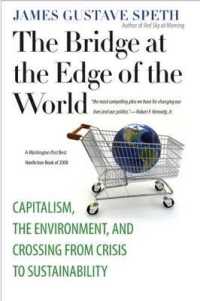- ホーム
- > 洋書
- > 英文書
- > Business / Economics
基本説明
This work uses varios model frameworks to study the evolution of equilibria in an open loop evolving economy.
Full Description
theory,whichformalizesa dynamiceconomicsystemasa systemofdi?erence, or di?erential, equations. There equilibria mean 'equilibrium trajectories' of the whole evolution that, in a certain sense, are optimal. A particularly un- tisfactory feature of this conceptualization of an equilibrium, however, is the factthattheintertemporaloptimizingapproachcompletelypredeterminesthe whole future of the economic system. This "closed loop" approach gives rise to the common reproach that economic theory is predominantly concerned with the question of 'how the economic system ought to behave' rather than with the question of 'how does it behave actually'. This is the point at which the new branch of evolutionary economics has made its entrance. In contrast to growth or business cycle theory, evolutionary economics perceives the evolution of the economic system as essentially "open" to true novelties that are unforeseeable by their very nature. This view clearly makes obsolete any conception of equilibrium that resorts to the idea of a ?nal state of rest, or to the idea of an intertemporally optimizing trajectory which is prespeci?ed ab initio by a system of di?erential equations and initial con- tions. To be sure, there have been attempts to reconceptualize the notion of equilibrium from the evolutionary viewpoint. However, these proposals also appear, in one way or another, to hinge on the ideas of rest. This parti- larly applies to the branch of nonlinear dynamics and deterministic chaotic motion.
Contents
General Introduction.- General Introduction.- Notations and Mathematical Preliminaries.- Notations and Mathematical Preliminaries.- Conceptualization and Definition of Evolutions of Economies in Four General Equilibrium Frameworks.- to Part I.- Evolutions in the Traditional Walrasian Exchange Equilibrium Framework.- Evolutions in an Exchange Equilibrium Framework Without Walras' Law and Homogeneity.- Evolutions in a General Equilibrium Framework With Production, Taxes, and Subsidies.- Evolutions in the Temporary Fixprice Equilibrium Framework.- Conclusions.- Formal Analysis.- to Part II.- Near-Equilibrium Paths.- Equilibrium Paths.- Economic Refinements of the Notion of an Evolution of Economies.- The Structure of the Equilibrium Price Set of an Evolution of Exchange Economies.- Comparison With Related Results in the Literature.- Conclusions.- Economic Analysis.- to Part III.- Applications of the Analytical Results From Part II in the Economist's Laboratory.- The Method of Kinetic Analysis of Evolving Economies in Historical Time.- Evolving Economies in Historical Time.- Conclusions.- General Conclusions and Outlook.- General Conclusions and Outlook.








